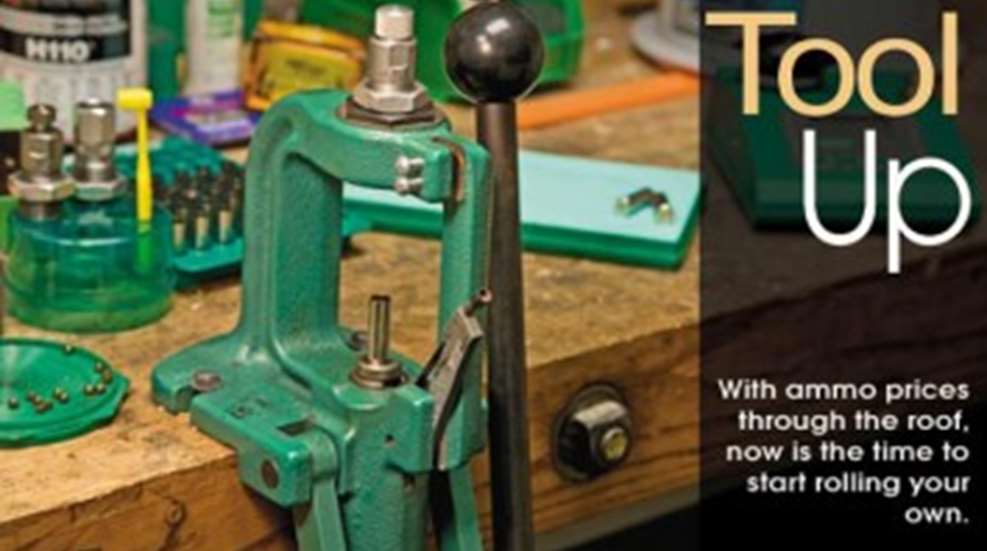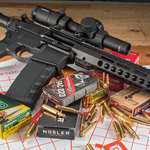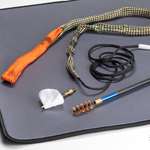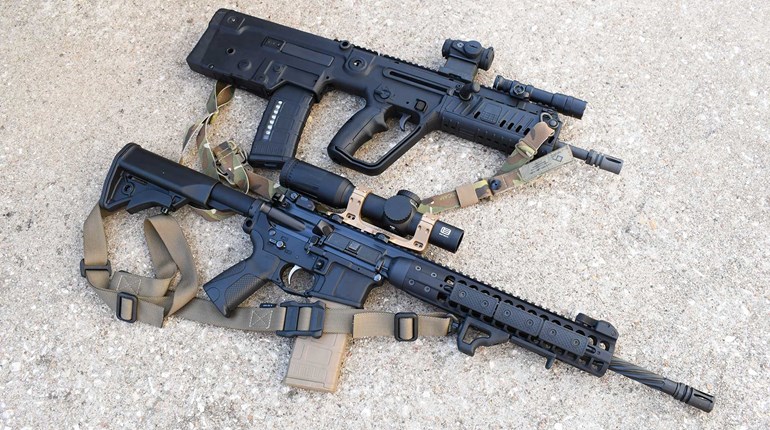
When Aaron Carter and I prepared a reloading seminar at this year's NRA Annual Meetings I figured we'd be lucky to get maybe 30 people to show up. About a week before the event I saw something from the National Shooting Sports Foundation stating fewer than 15 percent of shooters reloaded. I was taken aback. I thought most of us rolled our own at least part of the time. The presentation packed the meeting room—standing room only—and I'd guesstimate the audience at about 250 people. They were enthusiastic and had a lot of poignant questions.
After moving back to Wyoming last year, the first order of business after I got a roof over my head was to build another reloading bench. Yes, it's my job, but I also derive a great deal of pleasure loading my own ammo. The details of constructing that bench appeared in the September 2008 issue of American Rifleman on page 42. Each of us has our own needs and limitations, but after building three of these benches over the years I've learned a few things—even from this latest project. And I am sure when I build the "Ultimate Reloading Center" sometime in the not-too-distant future I'll incorporate what I've learned thus far and undoubtedly will learn a few more quirks and needs to make handloading more efficient and enjoyable.
Most of us get into loading our own ammo in order to shoot more for less money. Later, after we've acquired the basic tools and skills, our level of sophistication and needs increase. That is something to keep in mind when you start a project like this: Plan as much as you can for expansion.
A Place to WorkA loading bench is a work station, so its design needs to employ ease of use—I think the modern buzzword for this is ergonomics—efficiency and, of course, safety. My first loading bench was a corner of my dad's workbench I commandeered, so it had to serve multiple functions. This is a mistake. Anything multi-purpose must be a compromise. Handloading is a very precise endeavor requiring a lot of focus and concentration. If you are distracted by the clutter of other repairs and projects on such a bench, your ammo will suffer too—and your safety, as well as those around you, will be compromised. It is far better to have a small—even portable—dedicated loading bench than to punch some holes in your everyday workbench and have at it.
Whether your loading bench is a small, portable 18x18-inch stand or an 8-foot-long wonder bench, the first consideration is how high off the floor should you place the top. Too high, and you'll have to reach and readjust your grip with every stroke of the press. Too low, and you'll have to stoop or use a chair to work. Either of these conditions will tire you quickly, and you'll lose focus and concentration. I like to be able to sit on a shop stool or stand when I am loading ammo, so I make my benches 381⁄2 inches tall—about the same height found on most kitchen countertops. I am 5 foot 11 inches, so if you are taller or shorter, build your reloading bench to suit you.
The key to building a bench that will be a pleasure to work at is organizing so the tools and supplies you regularly use are close at hand. It's frustrating and time consuming to have to constantly get up and walk to a cabinet for a die or other tool. Since I handload more than two dozen cartridges, I built the two top drawers of my bench to hold die boxes on end, separated by dividers. They were a pain to build, and took me almost two weeks to complete, but were well worth it. Also, keep in mind that you need a shelf or cabinet close to where you do most of your work to keep reloading manuals. Even if you are just getting started with one bullet in one cartridge, eventually you will need more manuals as you experiment with different bullet-and-powder combinations. In this respect, handloading manuals are a lot like guns: You can't have too many.
Tooling UpYour loading press is the centerpiece of the bench. It is the tool that performs most of the work turning an empty case into a cartridge. I am not aware of any really bad presses, but it is possible to make a bad choice based upon one's particular needs. If you are new to handloading or have limited experience, a progressive press is not what you want for a first and only loading press. Progressive presses are great for churning out hundreds of rounds per hour when you need some cost-effective practice or match ammo, but for working up a load, a progressive is almost useless. Wait until you are ready to start loading in volume before you invest in a progressive loading press.
Turret presses are a compromise between the ability to load a few test loads and cranking out several hundred rounds in an evening. There are several good ones. The family-owned Lee Precision has a couple of turrets that are popular. Its Classic Turret Press is a robust model with a long enough stroke to accommodate the .50 BMG cartridge, though I personally would probably not want to stress a turret press with resizing that cartridge. If your plans don't include the big five-zero, then Lee's Turret Press can fulfill your needs. It is available with either a three- or four-hole turret.
Out in Oroville, CA, RCBS also manufactures a Turret Press. Its six-station turret allows a combination of dies and a powder measure to function as a progressive loader capable of yielding to 200 rounds per hour. Lyman has made turret presses for many years, and its latest version is the T-Mag II, a six-station press featuring an improved turret retention system that indexes smoothly, yet locks solidly at a given station.
Redding is another longstanding company in the reloading business, and its T-7 Turret press is a massive one as turret presses go. It has 313⁄16 inches of ram travel, allowing it to handle most magnum rifle cases. The T-7 has seven stations on the turret to provide space for the company's optional Sliding Bar Automatic Primer Feeding System that eliminates handling of primers during the sizing/priming process.
The quintessential O press is the single-stage press most handloaders have. I bought my first RCBS Rockchucker in 1973 and have loaded somewhere around 100,000 rounds with it over the years. I recently replaced it with a Rockchucker Supreme so I could load the Remington Ultra Mag family of cartridges. An O press is very strong. If your plans include case forming for wildcat cartridges, bullet swaging or any process where you need to move a lot of metal, the O-style press is a necessity.
Hornady makes an O press with a handy feature. Called the Lock-N-Load Classic, it includes a quick-changing die capability utilizing a twist-locking bushing to change dies instead of screwing in and out dies other presses require. Lee Precision offers its Classic Cast Press, featuring a very large opening and stroke so you can load virtually anything except the .50 BMG (specialty presses are available for that cartridge). The Classic Cast Press allows the user to switch the operating handle from right to left side to accommodate southpaws, and it has an adjustable start/stop position that employs a 48-tooth ratcheting system.
Thankfully, Lyman got away from the Orange Crusher—I found the garish orange color very distracting—but it retained and improved the Crusher concept into the Crusher II. The Crusher II has a 41⁄2-inch window that is large enough for just about anything you'd want to pour powder into. Its massive cast frame has a 14-square-inch base plate with three mounting holes to ensure it doesn't move or flex under load.
The Big Boss II from Redding is another large O-style press capable of handling modern super-magnum cartridges. It features a spent primer collection system to keep things tidy and an offset, straight-pull handle for comfort. It is available in kit form with a shell holder and your choice of a Series A set of dies.
Another press that received a bit of acclaim a few years ago is the Forster Co-Ax Press. Rather than relying on the massive steel casting of an O press, the Co-Ax utilizes two steel floating guide rods to ensure alignment. Its universal shell holder jaws float with the die and keep the case centered. Dies snap in and out without threading, and any standard 7⁄8x14 die will work in a Co-Ax press. An integral primer catcher keeps the floor free from spent primers and their parts.
Everything You NeedYou'll need more than just a press to reload, of course, so many of the aforementioned presses are available in kit form. These kits include everything you'll need to get started; generally a set of dies, a powder measure and funnels, scales, die bushings, primer catchers and trays, a priming system, a case-loading block, wrenches, deburring equipment, case lube and a vital reloading manual.
Redding offers the T-7 in a kit form and Lee packages the Classic Turret in a Deluxe Reloading Kit. The RCBS Turret Press is likewise available in a Deluxe Kit, while Hornady has a package including the Lock-N-Load press with a host of accessories. Lyman offers identical kits for both the T-Mag II and Crusher II, the only difference being the press itself. Setting up your reloading area is certainly easier when everything you need to start comes in one box.
Get InstructionIf you are new to handloading or have been away from it for some time, it would be prudent to take a course in basic reloading. Many gun clubs have an NRA-certified instructor to teach such classes. They're not expensive and can save you a great deal of time and frustration while getting your handloading operation up and running. If you have difficulty finding an instructor, contact John Howard at the NRA Education and Training Division, 11250 Waples Mill Road, Fairfax, VA 22030-9400. Howard is a great guy and eager to help shooters get pointed in the right direction.
Handloading is a very satisfying part of being a shooter and can actually enhance your enjoyment of the sport. It isn't difficult to learn, and will allow you to stretch your shooting dollar.

































